

4th - Physical Science - Magnetism & Electricity. Grade 4 Physical Science Magnetism and Electricity Written By: Hortencia Garcia Christina Mavaro Kathleen Tomscha Developed in Conjunction with K-12 Alliance/WestEd.

Diaper Inquiry. Summary:Believe it or not, this activity uses diapers to help students observe physical change.
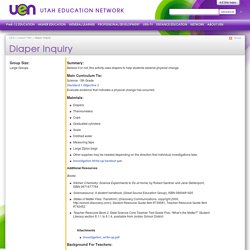
Main Curriculum Tie: Science - 5th GradeStandard 1 Objective 2Evaluate evidence that indicates a physical change has occurred. Materials: Diapers Thermometers Cups Graduated cylinders Scale Distilled water Measuring tape Large Ziploc bags Other supplies may be needed depending on the direction that individual investigations take. TRB 5:1 - Activity 6: Chemical Change. Summary:Students will conduct a variety of experiments to investigate the changes that occur in matter during a chemical reaction.
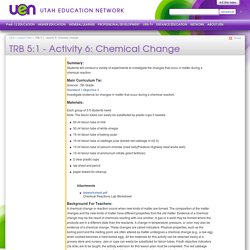
Main Curriculum Tie: Science - 5th GradeStandard 1 Objective 3Investigate evidence for changes in matter that occur during a chemical reaction. Materials: Each group of 3-5 students need: Note: The falcon tubes can easily be substituted by plastic cups if needed. 50 ml falcon tube of milk 50 ml falcon tube of white vinegar 15 ml falcon tube of baking soda 15 ml falcon tube of cabbage juice (boiled red cabbage in H2 0) 15 ml falcon tube of calcium chloride (road salt)(Prestone Highway Heat works well) 15 ml falcon tube of ammonium nitrate (plant fertilizer) 2 clear plastic cups lab sheet and pencil paper towels for cleanup Attachments labworksheet.pdf Chemical Reactions Lab Worksheet Background For Teachers:A chemical change or reaction occurs when new kinds of matter are formed.
The Heat is On! Summary:This activity gives students experience with chemical change.
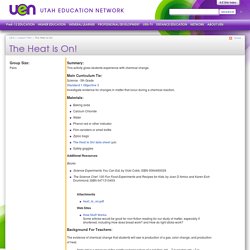
Main Curriculum Tie: Science - 5th GradeStandard 1 Objective 3Investigate evidence for changes in matter that occur during a chemical reaction. Materials: Baking soda Calcium Chloride Water Phenol red or other indicator Film canisters or small bottle Ziploc bags The Heat is On! Data sheet (pdf) Safety goggles Additional Resources. Search. Dvc.infohio.org/materials/210CurrentElectricty.pdf. Uncovering Student Ideas in Science: Volumes 1-4. Uncovering Student Ideas in Science, Volumes 1-4, provide a set of grades K-12+ formative assessment probes that link key concepts in science to commonly held ideas described in the research on learning.
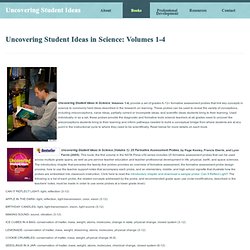
These probes can be used to reveal the variety of conceptions, including misconceptions, naive ideas, partially correct or incomplete ideas, and scientific ideas students bring to their learning. Used individually or as a set, these probes provide the diagnostic and formative tools science teachers at all grades need to uncover the preconceptions students bring to their learning and inform pathways needed to build a conceptual bridge from where students are at any point in the instructional cycle to where they need to be scientifically.
Read below for more details on each book. Uncovering Student Ideas in Science (Volume 1)- 25 Formative Assessment Probes, by Page Keeley, Francis Eberle, and Lynn Farrin (2005). CAN IT REFLECT LIGHT- light, reflection (3-12) IS IT MELTING? IS IT MATTER? StudyJams. StudyJams. StudyJams. Www.need.org/files/curriculum/guides/Energy Flows.pdf. Elementary resources. The Energy Story - Chapter 1: Energy - What Is It? Energy causes things to happen around us.

Look out the window. During the day, the sun gives out light and heat energy. At night, street lamps use electrical energy to light our way. When a car drives by, it is being powered by gasoline, a type of stored energy. The food we eat contains energy. Converting Energy. Purpose To introduce students to energy through the idea of energy transformations and conversions, and to develop students’ ideas of what energy is and how it can be measured.
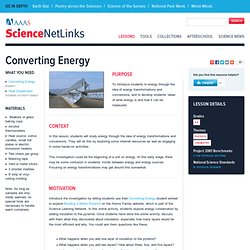
Context In this lesson, students will study energy through the idea of energy transformations and conversions. They will do this by exploring some Internet resources as well as engaging in some hands-on activities. This investigation could be the beginning of a unit on energy. Motivation Introduce the investigation by letting students use their Converting Energy student esheet to explore Building a Better Pyramid on the Atoms Family website, which is part of the Science Learning Network. What happens when you add one layer of insulation to the pyramid? Then have students go to Raceways where they can explore various forms of energy and may be a good way to provide a context for student thinking on potential and kinetic energy.
Development. TRB 4:2 - Investigation 2 - Thermometers. Summary:These classroom thermometer activities will help students understand how temperature is measured.
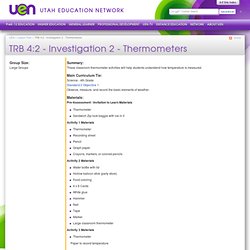
Main Curriculum Tie: Science - 4th GradeStandard 2 Objective 1Observe, measure, and record the basic elements of weather. Materials:Pre-Assessment / Invitation to Learn Materials Thermometer Sandwich Zip-lock baggie with ice in itActivity 1 Materials Thermometer Recording sheet Pencil Graph paper Crayons, markers, or colored pencilsActivity 2 Materials Water bottle with lid Hollow balloon stick (party store) Food coloring 4 x 6 Cards White glue Hammer Nail Tape Marker Large classroom thermometer Activity 3 Materials ThermometerPaper to record temperature Additional Resources Newspapers: Students can bring in newspapers with daily weather maps and forecasts. Phone Numbers: Some communities provide a current time and temperature phone number that students can call. The science of hot air balloons.